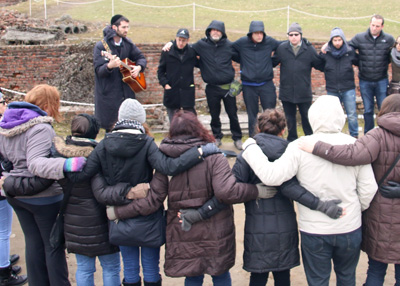Matzah, the Holocaust and the Jewish Drive
Permanent link
Chicago YJP at Auschwitz-Birkenau on a Poland-Prague trip.
After the Nazis had fled Bergen-Belsen knowing their demise was imminent, Izzy Starck and some friends searched the Nazi barracks to find a bunch of rifles. They were starving – that wasn’t what they were looking for. Nonetheless, they decided to take them for safety’s sake. Then, while taking in their first breaths of freedom as they continued their search for food, they saw a Nazi SS guard they recognized from the camp running with suitcases.
They surrounded him with their rifles. As the devil’s elf pitifully begged for his life, no one felt mercy for his wicked soul. They had all lost so much to his blood-stained hands and all of his fiendish comrades. One of the friends said to Izzy, “He deserves to die. Shoot him.” Izzy agreed and responded, “You’re right. Go ahead.” One by one, they all agreed he deserved to die, and they all told the next person to shoot him. But no one could.
It wasn’t a lack of desire for revenge that stopped them. As Izzy explains it 70 years later, “Maybe it just wasn’t in our genes? It just wasn’t in our blood to kill.”
Despite all the horrific atrocities they had been through, they kept the Jewish fundamental concept in mind – we build. That’s what we do. After so much destruction, they had a tremendous yearning to build. No more destroying. As Izzy Starck told us, “The revenge I have against Adolph Hitler wouldn’t come from killing an SS officer. It comes from four of my kids living in Israel and my 40-plus grandchildren.”
It comes from a lifetime of rebuilding the Jewish people and heritage.
On Passover, we lovingly eat our matzah. The matzah has two seemingly oppositional meanings to it. At the beginning of the Seder, we declare, “This is the bread of affliction.” This is the bread of oppression. It is the bread of destitution. Matzah is made of the same flour and water as all bread. What makes this particularly destitute bread? The answer is it didn’t rise. Not letting your bread rise is a choice a destitute man makes when he doesn’t care about taste anymore. Life isn’t worth living. Who cares if the bread is moist, soft, and risen or dry, rough, and thin? That’s the despondence of destitution. The slavery we remember of our ancestors was a destitute existence. And the matzah is apropos to the occasion.
However, we later proclaim that matzah is symbolically the bread of freedom. We recall toward the end of the Haggadah how the matzah reminds us of the speedy exit our ancestors took from their bondage, how they did not have time to delay and their unrisen bread testified to their haste. Thus, the same symbolic object juxtaposes these two polar opposite points of the Seder: oppression and freedom.
But how could this be? Doesn’t the matzah seem to naturally befit oppression, and the freedom symbolism is a bit of a stretch? How about just leaving the freedom symbolism to the four cups of wine and calling it a day?
The answer is seen in the story of the liberated Jews from Bergen-Belsen. You see, in Judaism, freedom is not really about luxury. Of course, free people have luxuries, and we express ourselves as royalty at the Seder night accordingly. But that’s not the full picture of what it is to be a free Jew. True freedom is the ability to build. We aren’t just seeking pleasures for the sake of fulfilling base desires. Some may even call that simply transferring the slavery to one’s body. We are looking to build. We want to build our nation, ourselves, and our heritage.
True, tasteless food is the bread of a destitute man. But there’s another man who eats tasteless meals. When a huge business tycoon is going in to work to seal the deal on a big project, he leaves the house that morning in a frenzy. He doesn’t have time to sit down to a fancy breakfast. At best, he just grabs whatever he can while rushing to the door and eats on the go while working out the final details of the project on his way to work. So too, we the Jewish people are huge business tycoons. But our business isn’t simply making big financial projects; we are looking to build our nation, ourselves, and our heritage. We don’t have time or energy to focus on petty rising food, revenge on Nazi blood, or any other detail that doesn’t help us on our mission. We are looking to build.
Therefore, the matzah is apropos as a sign of freedom. It’s a symbol that reminds us of how we handle our freedom. We seek to build. We seek to create generations to come, to build the generation we’re in, and to grow in our own spiritual strength. This is the way of our people. It was the way of our people upon their liberation from Nazi hell. It was the way of our people over 3,000 years ago from horrific slavery. And it is our way of building through all times. In every generation, they will come upon us and attempt to destroy us. But we will stand up to them, and we will build.
This piece was put together based on a lecture given by Mr. Izzy Starck at the recent Chicago YJP Poland-Prague Reunion. To find out more about the next Poland-Prague trip with young Jewish professionals and other upcoming events, email Rabbi Josh at josh@chicagoyjp.org. You can also find other stories of Mr. Starck’s experiences in his autobiography.



.jpg)



